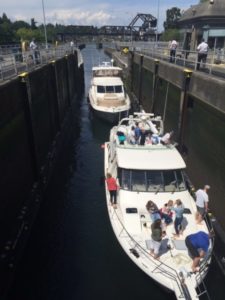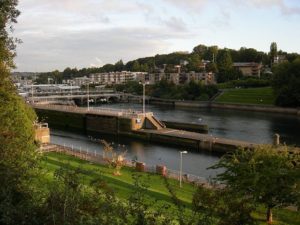If you boat in the Puget Sound region or Seattle – whether it’s with a sailboat, cruiser, powerboat, or kayak – odds are you’ll start in either the fresh water of Lake Union and Lake Washington, or the saltwater of Elliott Bay and the Puget Sound. To get from saltwater to freshwater or vice versa, you’ll have to navigate through the Hiram M. Chittenden Locks, otherwise known as the Ballard Locks. If you’re a Carefree Boat Club member, you can take advantage of our four locations: Fisherman’s Terminal in Seattle; Shilshole Bay Marina; Bellevue; and Anacortes, which means you don’t ever have to go through the Locks if you don’t want to – but if you do, we’ve got you covered.
Carefree Boat Club offers free training for our members on how to safely and expertly lock through this popular tourist attraction and heavily trafficked boating thru-fare, but we’d also like to give you an idea of what to expect ahead of time here. Let’s start with some simple and honest level-setting: if it’s summertime, you will become part of the tourist entertainment. This isn’t a bad thing, because you’re going to do great.
About the Ballard Locks
The Ballard Locks, according to Wikipedia, “carry more boat traffic than any other lock in the US, and the Locks, along with the fish ladder and the surrounding Carl S. English Jr. Botanical Gardens attract more than one million visitors annually, making it one of Seattle’s top tourist attractions.”
The Locks are open 365 days per year, 24 hours a day. Commercial traffic, including fishing boats returning from the Bering Sea and tourist boats like the Argosy Cruise vessels, help keep the lockmaster at attention year-round. On a warm summer weekend, the waiting time can be upwards of three hours, but if you pick the right day and time, it could only be 10 or 15 minutes.
The Ballard Locks are also a complex locking system, consisting of one large and one small lock. The small lock chamber accommodates one large boat or a dozen smaller boats and has walls that move with the boats so they go up and down as you do. The large chamber can accommodate over 200 small recreational boats if needed, and does not have moving walls – which means you must pay out your line as you lower down.
With training, locking through is pretty straight-forward. But every lockmaster and commercial boat captain has a story about watching boaters make mistakes in getting through the Locks, including Jay White, former captain of Argosy Cruises and current deckhand / captain for King County Water Taxi. Jay has been through the Locks upwards of 4,000 times. During one trip through the large locks, he had his commercial boat directly against the wall, with other boats rafted up to him. “One of the sailboats on the far outside released his lines before he was told to and started off with the stern, which caused his boat to spin,” said Jay. “He was trying to start the engine while it was spinning and snapped his mast on a bowsprit of another boat. But never once did he drop the cigarette that was in his mouth.”
What to know when going through the Ballard Locks
While this can all sound worrisome or intimidating, rest assured that our USCG certified captains here at Carefree Boat Club will give you complete training and will make sure you ready to go. In the meantime, here are a few things to keep in mind:
- All passengers must have their lifejackets on.
- Always listen to the lockmaster and do what you are told.
- When approaching, wait until you are called forward to enter. They will use the loudhailer to call you.
- Do not use the radio to contact the lockmaster; this is reserved for commercial boats to make passing arrangements.
- Be aware that there is a strong outbound current to Puget Sound – we’ll show you how to best manage this.
- When heading towards the Sound (or down bound locking), tie off the stern line first for safety as the current has a tendency to sweep the stern and pull the boat around. When departing this direction, they will ask you to release the bow line first.
- The order of lines should be reversed for inbound locking (salt to freshwater).
- There are waiting walls that you can tie up to on both sides of the locks. Use them unless you’re told to go through, as it can be intimidating with the big commercial boats and currents.
- Be polite and mindful of commercial traffic, especially tug boats moving barges. They can’t always see you and have limited maneuverability.
We look forward to seeing you at our office and to getting you on the water! If you are not a current member, please contact us here or call 206.567.2628 for more information.


